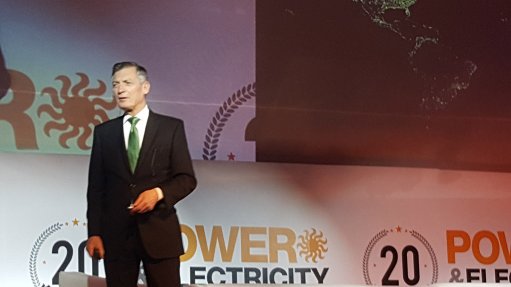
Professor Donald Sadoway
Liquid metal battery inventor Professor Donald Sadoway, of the Massachusetts Institute of Technology, believes the technology has the potential to provide the “missing piece” in an electricity market that relies on “redundancy and overcapacity” to balance supply and demand – a feature that will become even more pronounced as the penetration of variable renewable-energy supply expands.
Speaking at the Power & Electricity World Africa 2017 conference and exhibition in Johannesburg this week, the cofounder of a company called Ambri, set up with support from software billionaire Bill Gates to commercialise the battery, argued that grid-scale electricity storage could change the power market much as refrigeration had food supply.
“The grid is peculiar, because supply must be in balance with demand everywhere at all times . . . the only way we can achieve that is by overcapacity and redundancy, which leads to unparalleled inefficiency and excessive emissions. Now, if you add to that the environmental imperative, you’ve got intermittent renewables and the only way to compensate for intermittent renewables, in the absence of storage, is redundancy, overcapacity, which leads to unparalleled inefficiency.”
But for grid-scale storage to be feasible, the solution would have to be low cost and have a long service life, which Sadoway asserted was likely to make lithium-ion batteries unsuitable in the longer term. “Lithium-ion batteries were developed for portable applications . . . and while they are currently being deployed for large-scale applications, there is no record of the behaviour of these batteries in deep-discharge over long periods of time.”
By contrast, the liquid metal battery draws its inspiration from the large-scale industrial process of aluminium smelting, with the Ambri technology conceptualised as a way of holding rather than consuming electricity, as would be the case during the smelting process, and release the electricity on demand.
“So I looked at something that is massive and consumes vast quantities of electricity and tried to figure out how to turn it into a battery. Other people are looking at batteries and trying to figure how to make them big and cheap.”
Another important element for Sadoway was to employ earth-abundant materials, which were readily available.
The result is a battery with three liquid layers: a light low-density metal on top and a heavy high-density metal at the bottom, which make up the electrodes, separated by a molten salt electrolyte. The difference in chemistry between the two metals on either side of the molten salt generates the voltage. The liquid layers float on top of each other based on density differences and immiscibility.
“These three liquids lie on top of one another the way oil lies on top of vinegar . . . so there is no need for separators, no need for membranes and on discharge the magnesium wants to alloy with the antimony so the top layer gets thinner and the bottom layer thicker and the current goes through the external circuit. Then to recharge the battery, we force current through it and then electro-refine the magnesium back.”
At room temperature the materials comprise solid metal and salt, which improves prospects for licencing and transportation. In operation, though, the battery operates at elevated temperatures, maintained by self-heating during charging and discharging, and the materials become molten. “So, we use the heat generated as an asset, not a liability,” Sadoway enthuses, highlighting that lithium-ion batteries require constant thermal management.
The battery – which is silent, emission-free and has no moving parts – can act as both a source and a load. “Sometimes to balance the grid, the remedy is not more current, the remedy is to get rid of current – this can act as an instant load.”
Sadoway is also adamant that liquid metal batteries are cheaper than lithium-ion batteries, even with the expectations of vastly improved costs for lithium-ion in future – lithium-ion is currently projected by Bloomberg New Energy Finance to fall from over $300/kWh to around $73/kWh by 2030.
“In 2014, we were below lithium-ion, in 2016 we were below lithium-ion. Where are we today? We are below lithium-ion and we intend to stay below lithium-ion. The difference is that we can go 10 000 cycles without fading.”